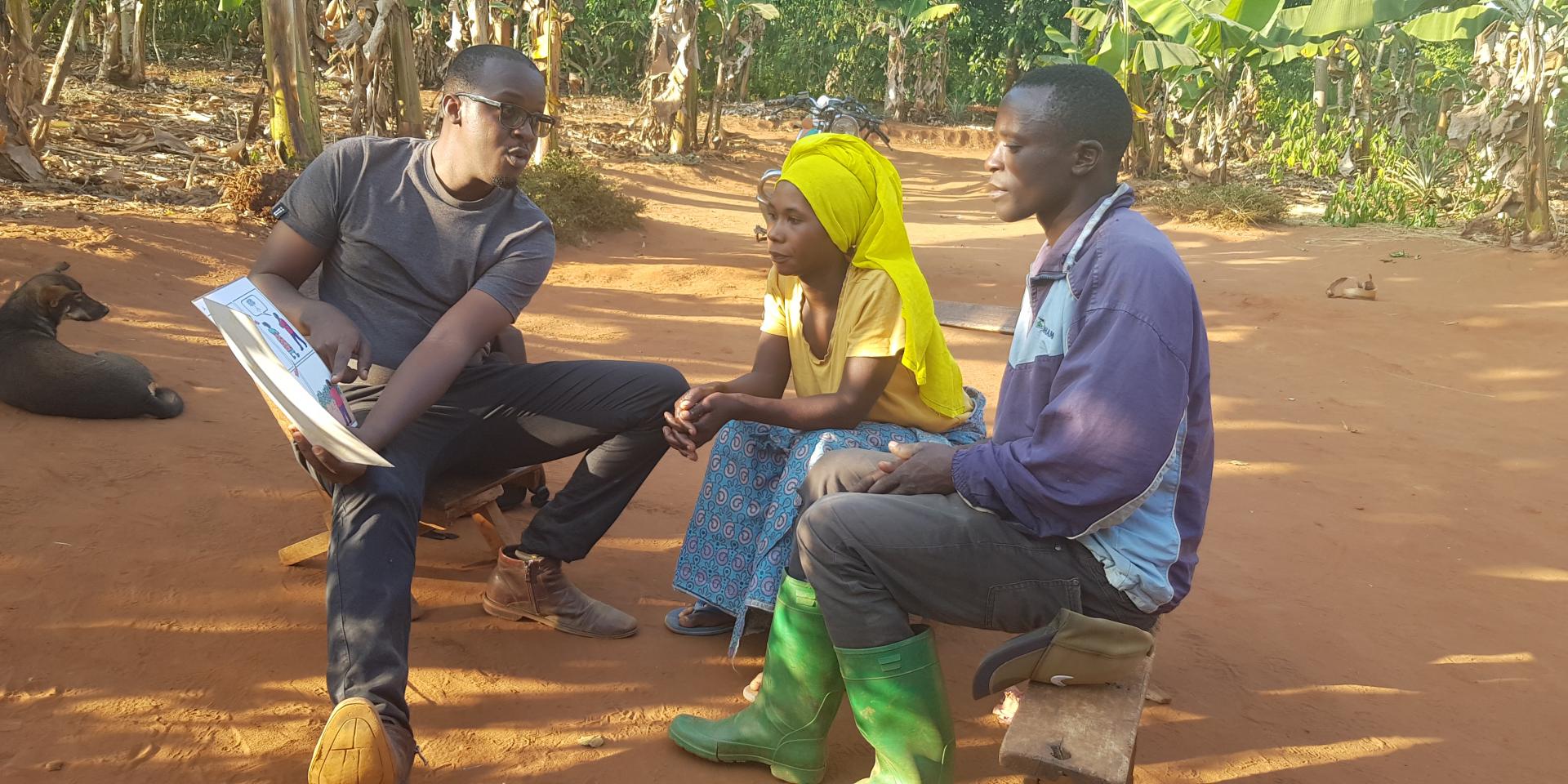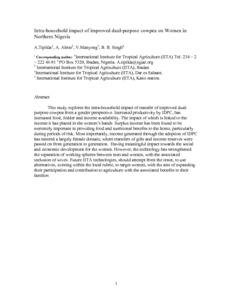Better understanding of intra-household decision-making with a locally informed mixed-methods research tool
 Photo: Devis Mwakanyamale/IITA.
Photo: Devis Mwakanyamale/IITA.
Understanding who makes decisions in farming households requires asking more than just who made the final choice. A new research tool can help.
A common approach to assessing women’s empowerment is to ask about their participation in decision-making within the household. There is growing criticism, however, of the standard tools and methods used to measure intra-household decision-making in low- and middle-income country contexts where agriculture is a mainstay livelihood strategy.
Most notably, existing tools and methods focus primarily on determining who makes decisions and less on understanding how decisions are made and the rationale for why decisions are made jointly or by an individual. While important, inquiring about who decides is insufficient to determine if women have agency or are empowered. In addition, most tool development processes use outsider perspectives to design decision-making questions, which fails to integrate local or insider perspectives that can significantly improve research on intra-household decision-making.
To tackle these key issues, we implemented a transdisciplinary research process that consulted a range of local stakeholders to inform the development of a mixed-methods research tool to measure and better understand intra-household decision-making. To do so, we formed a team of social scientists from the University of Dar es Salaam, the International Food Policy Research Institute and the International Institute of Tropical Agriculture. The research was funded by the CGIAR GENDER Impact Platform.
The mixed-methods research tool was developed and piloted in northwestern Tanzania (Kagera and Kigoma regions) with married/cohabiting couples (in both monogamous and polygynous relationships) who engage in activities within the cassava value chain. It can be adapted across agricultural value chains and geographies given that the step-by-step process we used to develop the tool was rather generic in nature, and thus, easily adaptable.
The mixed-methods research tool comprises a qualitative interview guide used to inform the development of the quantitative survey instrument and the quantitative survey instrument with short stories (vignettes) describing decision-making patterns by married/cohabiting couples when making important household decisions. The mixed-methods research tool is accompanied by a process guide developed to assist users when modifying the mixed-methods research tool to fit their needs and local contexts.
Qualitative research to uncover local decision-making patterns
The qualitative interview guide was developed to better understand who generally makes the final decisions within the household and why and how such decisions get made. We piloted the tool with 36 couples.

Interviewer and a note taker conducting the qualitative interview with a couple in Kagera Region, Tanzania. Photo: Innocensia John.
The tool yielded qualitative data that were later analyzed to look for patterns in how couples make cassava production, processing, and/or trading decisions and expenditure-related decisions. A total of seven decision-making patterns were identified.
Based on these, we developed seven vignettes to describe the ways couples make such casava-related decisions (see box below). There are three vignettes that describe patterns whereby the husband makes the final decision, two vignettes whereby the wife makes the final decision and two vignettes whereby spouses make joint decisions. For example, one vignette describes a pattern whereby the husband is the sole decision maker, yet the wife comes up with the original idea, shares it with her husband and they discuss jointly before he makes the final decision. It reads as,
“The wife realizes something needs to happen or a decision needs to be made regarding [X]. The wife shares her idea with her husband and they discuss jointly about the idea. After discussing, the husband confirms he is supportive of the idea and/or alternative options from either the husband or wife are considered before the husband makes the final decision.”
Short version of vignettes
- Vignette 1: Husband shares idea, discusses with wife and husband makes the final decision.
- Vignette 2: Wife shares idea, discusses with husband and the husband makes the final decision.
- Vignette 3: Husband shares idea, discusses with wife and they make a joint final decision.
- Vignette 4: Wife shares idea, discusses with husband and they make a joint final decision.
- Vignette 5: Wife shares idea, discusses with husband and wife makes the final decision.
- Vignette 6: Husband shares idea, discusses with wife and wife makes the final decision.
- Vignette 7: Husband shares idea with his wife before he makes the final decision.
The seven vignettes were validated in communities in and outside the study area using skits that were acted out by a local drama group to determine if the vignettes represented real-life scenarios of couples making said decisions.

Members of drama group acting out a vignette-based skit in Kigoma Region, Tanzania. Photo: Gloriana Ndibalema.

Focus group participant contributing to the discussion during vignette validation in Kagera Region, Tanzania. Photo: Gloriana Ndibalema.
Embedding the decision-making patterns in a quantitative survey instrument
The quantitative survey instrument consists of several modules that are commonly included in household survey tools that collect sex-disaggregated data from women and men in dual-headed households in rural agricultural contexts. The key feature of the survey tool is the module on intra-household decision-making. The decision-making module focuses on six topics related to cassava production, processing and marketing, and two topics on household expenditure. Each topic emerged as important based on our analysis of the qualitative data.
The first question in the decision-making module asks spouses who generally makes final decisions in the household on specific topics (e.g., on which cassava variety to plant). In the second question, spouses are read up to three of the vignettes, based on their response to the first question, and then asked to choose the vignette that is most similar to how they make decisions on the specific topic. To assist respondents in choosing a vignette, a local artist developed illustrations that depict the decision-making pattern described in each vignette (see example below).

Illustration example of a vignette (short story) describing a decision-making pattern, whereby the wife comes up with an idea and shares and discusses with her husband before he makes the final decision. Illustration credit: Nicodemus Silingo.
The third question asks spouses about the most important reason why final decisions about which cassava variety to plant is generally made in the manner described in the vignette they chose. The response options for this question come from the different reasons that spouses provided during the qualitative study on why they make decisions on their own or jointly together.
To examine if the decision-making module can be administered by bringing both spouses together to respond jointly or asking them to separate and respond individually, we pilot-tested both options. We piloted the survey instrument with 1,352 couples in randomly selected households in the study area. In half of the sample, spouses responded jointly to questions in each module including the decision-making module. In the other half, spouses were interviewed together except when responding to questions in the decision-making module.

Enumerator administering the quantitative survey instrument with a couple (joint interview) in Kagera Region, Tanzania. Photo: Devis Mwakanyamale.
Disseminating the mixed-methods research tool
After the mixed-methods research tool was piloted, a dissemination event for stakeholders was organized in the study area. Participants included researchers from the Tanzania Agricultural Research Institute (TARI), agricultural extension officers, senior agricultural officials and several development practitioners - most of whom were involved at different stages of the tool development process, for example, to inform the design of the qualitative interview guide, during validation of the vignettes and when piloting the different tools. The event brought stakeholders together to reflect on the tool development process and share the tool and get their feedback, including their opinions on whether the tool would be of use to them in understanding intra-household decision-making in their research and development programs.

Photo: Participant (back middle) making a contribution during the plenary session of the tool dissemination event in Kagera Region, Tanzania. Hadi Rashid.
Conclusion
The new mixed-methods research tool seeks to address the limitations of existing tools and methods to assess intra-household decision-making. The tool goes beyond asking who make(s) decisions. It further explores the processes involved in making such decisions and the reason why decisions are made individually or jointly. The tool contains vignettes with visual aids that serve as a stimuli and to help encourage respondents to discuss their thoughts more openly. Researchers and development practitioners can adapt or use the tool for measuring and better understanding intra-household decision-making on different topics and in different contexts.

